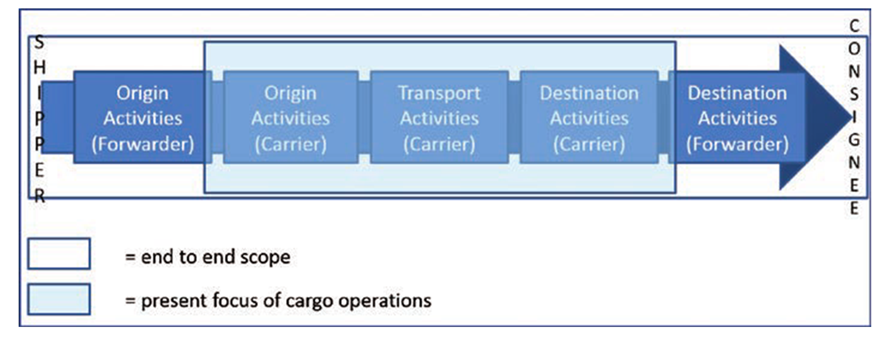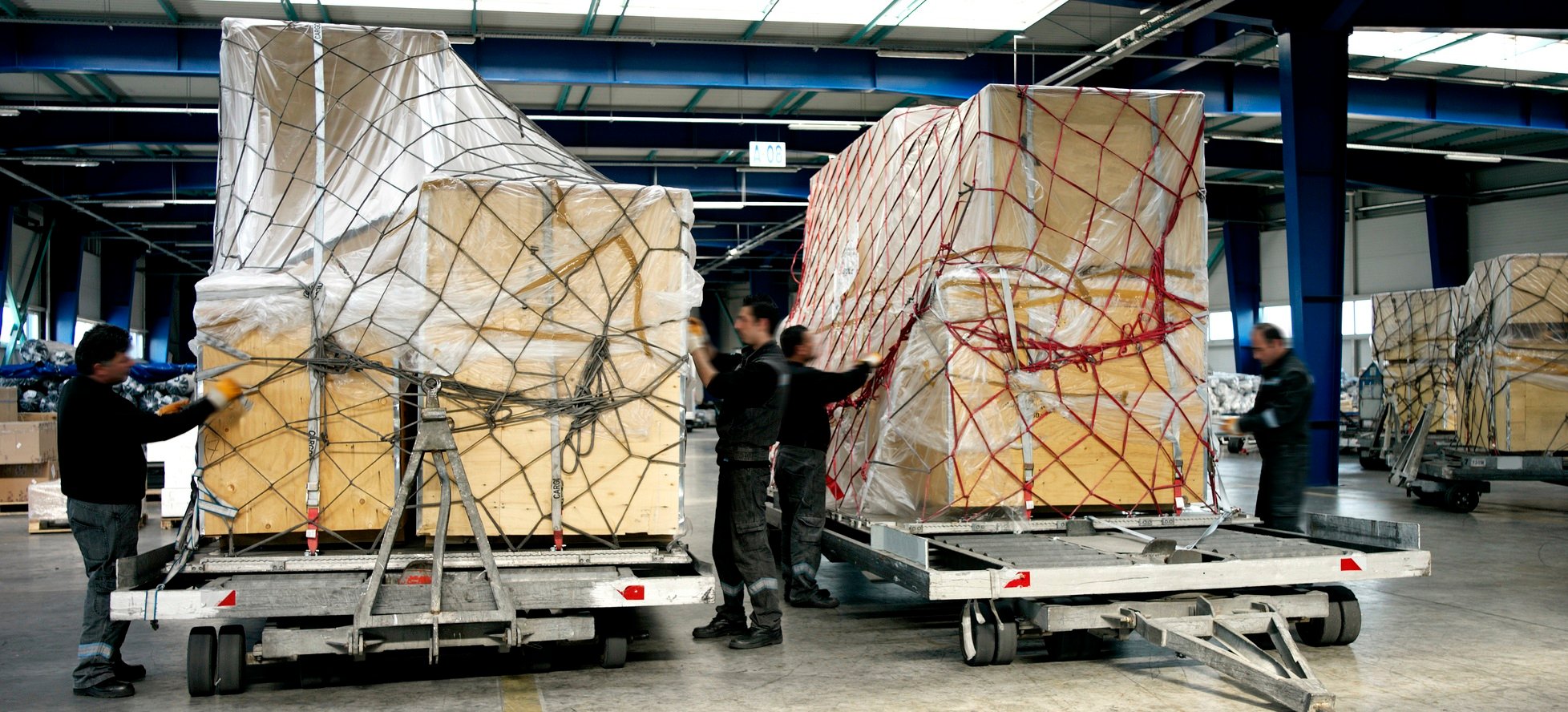
Shipping by air is a fast and efficient means of transport for goods. Airlines transport over 52 million metric tons of goods a year, representing more than 35% of global trade by value but less than 1% of world trade by volume. That is equivalent to $6.8 trillion worth of goods annually, or $18.6 billion worth of goods every day. However, the effects of COVID-19 on the industry dramatically affected the air industry including air cargo. Available cargo tonne-kilometers fell industry-wide by 21.4% year-on-year in 2020. However, by the end of the year, industry-wide cargo tonne-kilometers had returned to near pre-COVID values. With so much air cargo being shipped worldwide and so many different parties involved in the supply chain, it is important to take a look at cargo handling for air transport.

Cargo handling is the segment of the supply chain which processes goods landside in the cargo facility. From the delivery at the airport of origin until it is ready for loading on the plane, to the unloading at destination and handover to the consignee/freight forwarder, many steps are involved with cargo handling that must be closely followed to ensure shipments are delivered safely and securely. These steps are found in the cargo Master Operating Plan (MOP).
The Master Operating Plan (MOP) describes the key processes and sub-processes involved in transporting air cargo from shipper to consignee in a systematic and harmonized manner. It provides the air cargo supply chain with the first, industry-endorsed, standard description of the end-to-end process for transporting cargo by air.

As a result, the MOP comprises 19 main processes and 78 sub-processes split into five categories of activities as follows:
The primary objective for air cargo acceptance and handling is to ensure that consignments are ready for carriage in compliance with operator and IATA regulations, as well as with export and import rules of the countries through which the cargo will transit. In general, all items to be transported using commercial aircraft must pass through an acceptance process. There are certain procedures that must be followed regardless of the type of cargo. Other procedures may only apply to certain types of cargo.
The section below will provide you a quick overview of some of the key steps of the MOP.
The process of cargo handling begins with booking and planning shipments, there is much to be done before the shipment even leaves the facility. Having a solid plan of action allows for smooth booking and prevents fewer problems further down the chain of events. It is necessary to follow the steps below to book your shipment properly. These activities also include the steps handled by freight forwarders as listed below:
The next step in logistics is how air cargo is received and accepted for transport. This is a multi-step process that includes various stockholders including trucking companies, as well as cargo and ground handling service providers amongst others.
Throughout the shipment process, safety remains a priority for all parties of the air cargo supply chain. For instance, it’s important to ensure clear and correct labeling and identification of packages. In addition, the packages themselves must be suited to the content and be able to protect the goods from any damage.
Let's take a closer look at what happens once the shipment is received by the carrier when it comes to discussing air cargo handling as so much of the preparation for the flight happens there.
Once the freight forwarding truck arrives at the carrier's domain and the truck driver has informed the Cargo Handling Agent of their arrival, the carrier domain can receive the goods. They should have received the following information in advance, which is why filing electronically is always recommended:
Once the information has been received, and the truck has arrived, an unloading slot and position will be assigned to the driver. Different slots are given according to needs, such as dangerous goods, live animals, ULDs, healthcare products, and more.
When accepting shipment as ready for carriage, airport cargo and ground handling personnel must take several steps to meet the requirements to ship goods by air. First, they must verify if the shipments are security cleared. Then they must perform a ready-for carriage check. This entails verifying that all the information aligns with the actual shipment and ensuring all embargoes and operational restrictions are applied. Once everything has been checked, the information is validated against the booking and updated. The primary objective is to ensure the consignments are in compliance with
After accepting shipments ready for carriage, airport cargo and ground handling personnel can prepare the air cargo for flight. The goods in transit must be received and security cleared once again. Goods left on the aircraft that are in transit are considered transit cargo. Cargo and ground handling services must give this transit cargo security checks, including x-ray and Explosive Trace Detection (ETD) screening. A detailed exam of the e-AWB, integrity of the cargo, and piece count is made. Once the pre-plan details are received from the carrier, a build-up plan must be prepared, which indicates what air cargo is to be built for flight, and the information is sent to the warehouse.

Now it is time to move the loaded ULDs to a secure flight holding area while being mindful of all sensitive information such as temperature-controlled and dangerous goods. Ensuring no flights are delayed, the ULDs can be lined up in order, if it is known, to prepare for ramp transportation. All ramp safety protocols must be followed. To avoid accidents being mindful of all ground support equipment during the process of loading and unloading is necessary. This is why proper training in IATA's rules and regulations is imperative for all cargo and ground handling personnel.
At this time, the control of the air cargo passes from the warehouse operator to the ramp handler. The transport of goods from cargo terminal to aircraft is a multi-step process best lined out in the IATA Cargo Handling Manual (ICHM). After following each of those steps explicitly, you would load the aircraft according to the load plan, making a note of arrangements for special cargo. Once the aircraft is loaded, any discrepancies must be addressed by updating the electronic Flight Manifest. It is now that the aircraft can depart, but the cargo loading procedure is not complete without mailing the flight manifest, loading, and carriage information.

How air cargo is unloaded involves fewer steps for airport cargo and ground handlers than the shipping and loading process. There are still many rules and regulations cargo and ground handling personnel must comply with, however. Following ramp safety protocols while performing tasks in a methodical manner help alleviate accidents and keep aircraft turnaround times in check. According to the IATA Cargo Handling Manual, the following are the specific steps to unloading air cargo:
Once the truck has collected the goods from the carrier’s domain it is transferred to the freight forwarder hub where it’s unloaded and checked. Often before goods are dispatched via a Forwarder Branch Facility before being handed to the Consignee and then they are finally delivered to the final customer. These steps fall under the following chapters of the ICHM where you’ll find more details about each step:
The IATA Cargo Handling Manual (ICHM) is a publication of the most current recommended practices for airline stakeholders to follow. It gives all the required documentation in an accessible step-by-step format. It was developed by an IATA council named the ICHC (IATA Cargo Handling Consultative Council) founded in 2011 by the Cargo Advisory Council (CAC). "The IATA Cargo Handling Manual (ICHM) covers all working instructions door to door, from shipper to consignee, with a strong focus on airport to airport activities where cargo handlers and airlines operate," according to André Majeres, Cargo Mail & E-Commerce Operations Manager at IATA.
The current issue contains 19 chapters in line with the Master Operating Plan (MOP). It includes the most up-to-date regulations regarding cargo handling and 10 appendices to expand on the subject, including a glossary, charts, various agreements, and more.
Anyone in the air cargo supply chain should use the IATA Cargo Handling Manual (ICHM). This includes airlines, shippers, cargo agents, and many others. It allows you to see where each level of risk exists in the handling of air cargo. This manual meets every airline's guidelines, which is important since too many airports require their cargo handlers to operate under the guidelines of each specific airline. This could mean complying with 100 different working instructions, which is a lot to be expected and is a costly and timely practice. By using IATA's manual for meeting the rules and regulations, you save time and money.
You can find more information about the most up-to-date cargo handling guidelines that are strict enough to cover each airline in the IATA Cargo Handling Manual (ICHM). In it, you will find everything you need to be compliant with the rules and regulations, and to follow the 19 steps of the MOP to mitigate the risks when handling air cargo.